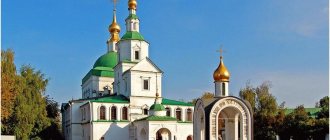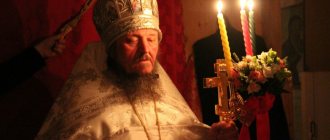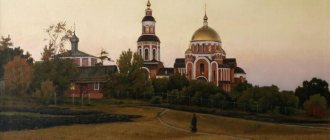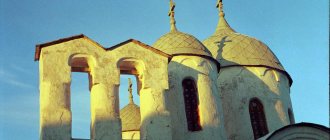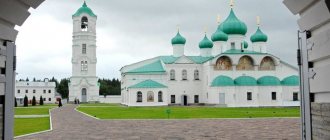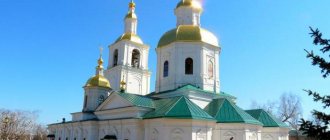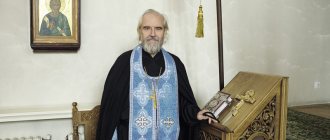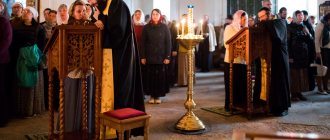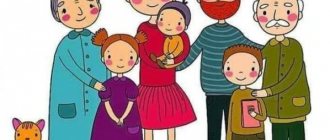| Reconstruction of the Kaluga Laurentian Monastery |
Kaluga Monastery in the name of the Nativity of the Blessed Virgin Mary and Blessed Lawrence of Kaluga
, bishop's metochion of the Kaluga diocese
- Address: Russia, Kaluga, Shirokaya street, building 49
- Official site:
- On the map: Yandex.Map, Google map
The monastery was founded on the site of the exploits of Blessed Lawrence of Kaluga after his death in 1515.
Prince Simeon of Kaluga ordered to bury Lavrenty in the then wooden Ascension Church inside the princely residence. The region of Kaluga in which the monastery is located has been called Podzavalie since ancient times. In the 18th century, the buildings around the church became stone. The church itself was already white stone in 1656. In 1716-1719, the brick building of the future seminary was built (the building was preserved - it later housed the House of Kaluga Archbishops).
The monastery enjoyed the patronage of all Kaluga residents, the rich donated for construction and decoration. The necropolis of the monastery was made up of the graves of honorary citizens. In 1812, the heroes of the Patriotic War, generals Baggovut and Vsevolozhsky, as well as all three main architects of Kaluga: Nikitin, Yasnygin and Sokolov were buried there.
The Krestovsky Monastery, founded in Kaluga in the mid-19th century, was assigned to the Laurentian Monastery.
| View of the Kaluga Laurentian Monastery from the south in 1861. |
The monastery was closed in 1918, and from August 15 of the same year the Kaluga infantry command courses were located here.
In May 1920, a forced labor camp was located on its territory, which was in charge of the punitive department of the Kaluga Gubernia Executive Committee. Political prisoners, criminals and prisoners of war were held here. In 1920, there were 317 prisoners per 100 camp beds. In 1921, by order of the camp commandant, the sculptural tombstones of the Laurentian necropolis were broken using blacksmith hammers. In May 1921, 230 Tambov peasants, participants in the uprising of the “Union of Labor Peasants”, led by A. Antonov, were transported here. In this regard, in November 1921, it was decided to adapt the lower floor of the Church of the Nativity into a prison building. Then the wall paintings were painted over and bunks and stoves were installed. Museum workers managed to save only part of the icons and utensils. On March 23, 1929, at a meeting of the All-Union Communist Party (Bolsheviks) faction of the Kaluga City Council, headed by Abarshalin, among others, a resolution was passed on the liquidation of the Lavrentiev Monastery. On March 27 of the same year, by agreement with Abarshalin and the secretary of the provincial executive committee Martsinkovsky, permission was received from the Moscow specialist of the Main Science Department N. Levinson and a member of the board of the People's Commissariat of Education Epstein to demolish the cathedral Nativity Church. One of the surviving buildings housed a secondary school, the others were inhabited. On the territory of the monastery, including on the necropolis site, temporary houses were built, in which people still live. Many buildings of the monastery were destroyed, tombstones were destroyed. The pond and park at the monastery have been partially preserved.
In 1988, a restoration workshop was located here, and a school was built in the northeastern part. In 1991, the historical territory of the monastery, including the monastery gardens, park, pond and spring, was declared a natural monument of local importance.
| Kaluga Lavrentiev Monastery. Photo by Dmitry Ivanov, 2008 |
On November 6, 1993, over the supposed burial place of Righteous Lawrence, a wooden cross was erected and consecrated by the Archbishop of Kaluga and Borovsk Clement and an unquenchable lamp was lit.
In the fall of 1994, part of the premises of the only surviving building of the former bishop's house was transferred to the Kaluga diocese, and on December 29, 1994, the Bishop's courtyard was formed there - the Kaluga St. Lawrence Monastery. The Laurentian Monastery was restored, and the activities of the Church of Sergius of Radonezh were revived. In 1995, the 480th anniversary of the death of the righteous Lawrence was solemnly celebrated.
Currently, in the part of the building transferred to the Church, a house church is equipped, which acts as a parish church, and a monastic community is being formed. Services are held regularly. Every morning prayers are served in front of the revered icon of the righteous Lawrence. On Sunday evenings, a canon with an akathist to the Saint is sung. In 1995, on the site of the altar of the destroyed Nativity Cathedral, a chapel was erected and consecrated in honor of Righteous Lawrence. Every year on August 23, on the day of memory of Righteous Lawrence, the Divine Liturgy is celebrated in the monastery on the site of the Nativity Cathedral in the open air. At this time, the chapel becomes an altar, and the entire space in front of it becomes a temple.
Kaluga St. Lawrence Monastery and St. Righteous Lawrence
The Kaluga St. Lawrence Monastery was founded in 1515, when Kaluga was an independent principality, given by the Grand Duke of Moscow John III as an inheritance to his fourth son, Prince Simeon of Kaluga (1487-1518). This is the oldest monastery in the city of Kaluga and the entire Kaluga land.
The monastery is dedicated to the Holy Righteous Lawrence of Kaluga (? -08/10/1515), whom the pious Prince Simeon sheltered in his house. Having taken upon himself the feat of Christ for the sake of the holy fool, blessed Lawrence loved to pray in solitude half a mile from the city of Kaluga, on a high hill, not far from a lonely church in the name of the Nativity of Christ. There, according to legend, he built himself a hut to carry out the feat of foolishness, fasting and prayer. “On ancient icons kept in churches and houses of the Kaluga region, the Righteous Lawrence is reverently depicted barefoot, as he walked winter and summer, in a shirt, ports and sheepskin, with an ax mounted on a long shaft...” So why is he holding an ax in his hands?
Saint Lawrence was and remains the prayerful protector of the Kaluga land. When the Tatars attacked the city of Kaluga in 1512, he saw this with his spiritual gaze, shouted, demanded an ax, took it and rushed to the battlefield to defend Prince Simeon and the Russian army, not so much with his terrifying appearance, but with prayer and a fearless call: “Do not be afraid.” ! And then the course of the battle, already almost lost by the Russians, changed. The Tatars were defeated. Since then, both the authorities and the city of Kaluga have revered St. Lawrence as their savior. And in 1515, after the repose of Righteous Lawrence, he was buried with honors “... in his beloved Church of the Nativity of Christ, where to this day they rest under the cover of his Holy relics, exuding healing to all who come with faith.”
Interesting Facts
- The Laurentian Monastery was always a monastery, but was rebuilt as a military fortress. False Dmitry II, having taken refuge in it after fleeing Kolomna, rebuilt the monastery walls, adding tours and battlements, and also strengthening the slopes of the hill on which the monastery is located.
- It is believed that False Dmitry II died in the territories belonging to the monastery. He, with the head of the guard - the Tatar prince Urusov, went hunting. There was a squabble between them and Prince Urusov cut off the head of the self-proclaimed usurper.
- The author of the Latvian stamp is the famous Latvian artist, musician and composer Juris Gribuls. The basis for the brand was an icon specially painted for this purpose. The blessing for painting the icon was given by the Metropolitan of Riga and All Latvia, Alexander. It is curious that Juris himself is Orthodox and has an artistic education in icon painting.
- The ceremonial cancellation of the stamps took place on the same day, a couple of hours apart. In Latvia at 9-00, and in Russia at 12-00[7][8].
A little more history
Over the centuries, at the burial site of St. Lawrence, a strong stone monastery grew up, beloved by Kaluga residents. Many famous honorary citizens and heroes of Russia were buried on the territory of the monastery. Thus, in 1812-1813, the heroes of the Patriotic War, generals K.F., were buried in the monastery cemetery. Baggovut and AM Vsevolzhsky. In the 18th century, Catherine II visited the monastery; in the 19th century, N.V. Gogol, members of the royal family. At the very end of the 18th century, the Kaluga diocese was established and the St. Lawrence Monastery was transformed into the Akhiereysky metochion. After 1917, almost all the buildings of the monastery - temples, tombstones, and even the monastery walls were destroyed.
In 1991, the territory of the monastery was given the status of a natural monument of local significance. Three years later, part of the building of the former bishop's house was returned to the Kaluga diocese. And at the end of 1994, the Bishop's courtyard was created here - the Kaluga St. Lawrence Monastery.
Now virtually everything that has been preserved from the monastery has been returned to the monastery. Active restoration work is underway.
LAVRENTIEV OF KALUGA IN HONOR OF THE CHRISTMAS MONASTERY
Monastery of St. Lavrentiy in Kaluga. Photo. Beginning XX century
Monastery of St. Lavrentiy in Kaluga. Photo. Beginning XX century Founding of L.K. m. in the 16th century. associated with the name of the blzh. Lawrence of Kaluga († after 1512). According to the Legend of the Miracles of St. Lawrence (known in lists of the 17th-18th centuries), in the beginning. XVI century he lived at the court of the Kaluga appanage prince. Semyon Ivanovich († 1518) (Simeonovo settlement), as well as in a hut next to a wooden church. in honor of the Nativity of Christ, located in several. kilometers from Kaluga, on the banks of the river. Yachenki. According to oral tradition included by Archbishop. Philaret (Gumilevsky) in the biography of the blessed one. Lawrence, the ascetic dug an underground passage from the hut to the church (Filaret (Gumilevsky). RSv. T. 2. P. 477-480), the existence of which in the monastery was later reported. there was a strong belief.
In 1512, during the battle of Prince. Semyon Ivanovich with the Crimean Tatars on the river. Oke, St. Lawrence unexpectedly appeared among the princely army, strengthening and encouraging them, after which victory was won. Time of death of St. Lawrence is unknown. In the list are Tales of his miracles, dating from the 2nd half. XVIII century, it is indicated: “How long the saint lived and in what year he died is unknown” (RSL OR. F. 178. No. 9578. L. 9 vol.). Traditionally, the year of death of the blessed one. Lawrence was considered 1515th. Probably, this dating is based on an incorrect reading of the only date contained in the description of the saint’s lifetime miracle: 7020 (1512) was read as 7023 (1515) (Romanova 2004, p. 239). After his death, the saint was buried under the c. in honor of the Nativity of Christ.
According to historians of the 19th century - early. XX century, monastery at the Nativity Church. founded the book Semyon Ivanovich. At first the monastery was called Rozhdestvenskaya, and then Lavrentievskaya. In the charter of Tsar Ivan IV Vasilyevich the Terrible in 1565, “the monastery of the Nativity of Christ, where Lavrenty, the holy fool for Christ’s sake, lies” (Leonid (Kavelin). 1906. p. 9).
In 1606-1607 The inhabitants of L.K.M. witnessed the defense of Kaluga by the troops of I.I. Bolotnikov. In Jan. In 1610, False Dmitry II, who fled from Tushino, stayed at the monastery. With the help of the brethren L.K.M., he managed to win over the Kaluga residents to his side, but already on December 11. the same year he was killed not far from the monastery. In 1617, a battle took place near the L.K. m. between the Polish. detachments of P. Opalinsky and S. Chaplinsky and the army of Prince. D. M. Pozharsky, sent to protect Kaluga. In 1618, Kaluga and, apparently, the monastery were devastated by the Cossacks of Hetman P.K. Konashevich-Sagaidachny.
In an extract from the Kaluga scribe books of G. Pleshcheev and G. Semenov, 1628 and 1629. Mention is made of 3 letters of grant from Tsar Mikhail Feodorovich, who granted L.K. the right to fish on the river. Oke granted the mill and confirmed the right of ownership of the monastery estates. In 1654, Patriarch Macarius III of Antioch and the archdeacon visited Kaluga. Paul of Aleppo, who mentions in the description of their trip “two majestic monasteries: one for monks, the other for nuns.” The first obviously means L.K.M. In the same year, the city and its surroundings suffered from a plague epidemic, the victims of which were the abbot and 4 hieromonks of L.K.M., 8 monks survived.
In 1776, Moscow and Kaluga Archbishop. Platon (Levshin) transferred to the monastery a school opened a year earlier for children of the clergy of the Kaluga province, consisting of higher and lower grammatical departments. The rector was the rector of the monastery, Archbishop. Plato also actively participated in the life of the institution. 300 rubles were allocated from the treasury for the maintenance of the school. annually, archbishop. Plato sought additional means. A library was organized at the school. In 1779, the bishop drew up instructions for the rector, and appointed teachers from graduates of the Slavic-Greek-Latin Academy. Teachers and students were required to attend religious services religiously. In the 70s XVIII century There were 120 students, in the 90s - 184 people. One of the students of the school was the Exarch of Georgia, Metropolitan. Jonah (Vasilevsky (Vasilevsky)), later. he sent a panagia decorated with precious stones and a number of books as a gift to the monastery.
In 1799, with the formation of the Kaluga and Borovsk diocese, a bishop's house and a spiritual consistory were established in L.K. m., and the monastery became unemployed. Bishop settled in L.K.M. Theophylact (Rusanov). The Kaluga bishop became the rector of the monastery, and the governor ruled the monastery. There was not enough space for new institutions, and in 1800 the consistory and the educational institution were transferred to Kaluga, transformed into a seminary. L.K.M., assigned to the bishop's house, remained the summer residence of the Kaluga bishops.
Pilgrims returning from the famous Tikhonova Kaluga in honor of the Dormition of the Most Holy. Mother of God of the Desert, often visited L.K. m. Visited the monastery: December 17. 1775 - imp. Catherine II Alekseevna, July 12, 1837 - led. book Alexander Nikolaevich (later Emperor Alexander II Nikolaevich) accompanied by the poet V.A. Zhukovsky, in July 1849 - N.V. Gogol, May 10, 1887 - leader. book Konstantin Konstantinovich, June 16 of the same year - Moscow Metropolitan. Ioannikiy (Rudnev), June 30, 1888 - leader. book Vladimir Alexandrovich led. Kng. Maria Pavlovna, July 10, 1889 - Kiev Metropolitan. Plato (Gorodetsky). In 1897, the Minister of Public Education, gr. I. D. Delyanov.
Aug 10 In 1915, the 400th anniversary of the death of the blessed one was widely celebrated in the monastery. Lawrence. The preparations were carried out by a special committee established in the Kaluga diocese in 1914 on the initiative of the Kaluga bishop. Georgy (Yaroshevsky). A collection of donations was opened, and with the funds raised, work was carried out to tidy up and decorate the monastery buildings. Before the celebration in the Nativity Cathedral on August 7. Parastas was celebrated, and on August 8 - a funeral liturgy with the commemoration, according to the monastery synodik, of all the deceased Kaluga bishops, abbots and those buried in the monastery. On the same day, the miraculous Kaluga Icon of the Mother of God was brought to the monastery and installed in the upper church. Aug 9 A solemn all-night vigil was served. Aug 10 A religious procession from all the churches of Kaluga and villages that previously belonged to L.K. arrived at the monastery, a solemn liturgy and prayer service were performed. Lawrence. In celebrations in addition to the Kaluga bishop. George was attended by Met. Moscow St. Macarius (Nevsky), vicar of the Tula diocese, bishop. Kashirsky schmch. Juvenaly (Maslovsky), prmts. led Kng. Elisaveta Feodorovna, abbess of several. wives monasteries and communities of the Kaluga diocese and wives evacuated to Kaluga during the First World War. monasteries of the Kholm diocese. There were 2 choirs singing: the bishop’s and the nuns of the Kholm diocese.
In the 19th century archim. Arseny composed the poem “A View of the Laurentian Monastery” (GA Kaluga Region F. 64. Op. 1. D. 27). The history of L.K. m. is described in most detail by archim. Leonid (Kavelin) in “Historical Description of the Kaluga Laurentian Monastery, the current Kaluga Bishop's House and the Cross Church belonging to it” (Kaluga, 1862). The celebrations of 1915 are described in detail in the newspaper. "Kaluga Church and Public Bulletin".
Territory and buildings
L.K. m. was located on a hill and was a serious fortification. In the 30s XVIII century it was surrounded by a brick fortification wall approx. 1 m and height approx. 3 m, forming a square in plan, and in the corners there were 4 octagonal towers. Above St. In 1732, the gate was built with a stone single-domed church. in honor of the Dormition of the Most Rev. Mother of God. Its plan consisted of 4 incomplete semicircles along the main axes and 4 smaller ones with windows along the diagonals. Since the 19th century due to the cramped conditions of the service in the Assumption Church. were not carried out. Underneath there were 2 passages covered with box vaults. All R. XIX century to the southeast and southwest summer cells are located in the towers, and glaciers are located below.
Lavrentiev Monastery in honor of the Nativity of Christ. Photo. 1878 Lavrentiev Monastery in honor of the Nativity of Christ. Photo. 1878
In L.K. m. there was a 2-story single-domed cathedral church (1650): the lower stone floor with a c. in the name of martyr. archdeacon Lavrentiya, upper wooden floor with c. in honor of the Nativity of Christ. In 1790, the lower church was restored, and in 1855 it was consecrated in the name of Blessed. Lavrenty Kaluga. The lower church had a low ceiling supported by a thick column in the center and small windows. Since 1769, the sacristy was located here. On one of the walls there was a marble bas-relief image of A. F. Demidova († 1805). Entrance doors south. the walls were decorated with archivolts and triple architraves of columns with lintels in Indus. style. The outside walls were lined with limestone. Upper Rozhdestvenskaya Ts. was originally wooden, “with three tops”, and in 1739 after a fire it was replaced by a stone two-altar (the left side chapel is in honor of the Nativity of Christ, the right side is in honor of the Ascension of the Lord), expanded in 1776, consecrated in 1780 . A distinctive feature of the upper church was the iconostasis in the Rococo style with wide cornices, the images of the belts were separated from one another by columns. The upper church was illuminated by two-light windows; an octagon was built above it, topped with a dome, and above it was another small octagon with a dome. The apse was 5-sided.
The cathedral church was surrounded by covered galleries from the south, west and north. From the south and north they turned from the temple at right angles and ended in turrets. From the west the gallery was connected to the bell tower, from the south through the tower - to the abbot's chambers. Stone bell tower, erected in the 30s. XVIII century in the Gothic style, had 3 tiers: the upper and middle ones in the corners were decorated with triple columns, and their cornices on 4 sides were decorated with kokoshniks. In the 80s XVIII century The bell tower was built on and a striking clock was installed in it.
In 1733, the construction of a stone 2-story abbot's building began, which became the bishop's building in 1799. It housed the bishop's chambers, office, servants' cells, refectory, and kitchen. In 1776, a room for a religious school was added to the right side of the building, in the 1st floor. 20s XIX century it was broken, a house center was built in its place. in the name of St. Sergius of Radonezh. In 1764-1765 a one-story brick building of fraternal cells and a school for children of full-time ministers was built in the north. parts of the monastery, later a 2nd log floor was added. Also in the 18th century. treasury cells and a number of other stone buildings were erected.
There was a source of drinking water on the territory of the monastery. On all sides the cathedral was surrounded by a monastery cemetery, on which rested the ashes of the heroes of the Patriotic War of 1812, Lieutenant General K. F. Baggovut, Major General A. M. Vsevolozhsky, senator and poet Yu. A. Neledinsky-Meletsky , architects of Kaluga P.R. Nikitin, I.D. Yasnygin, N.F. Sokolov, representatives of the families of the Bilibins, Demidovs, Zolotarevs, princes Obolensky, Pryanishnikov, Sukhozanetov, Unkovsky and others. There were 2 chapels in the cemetery: in one he was buried the holy fool Yermil, who lived in the end. XVII - beginning XVIII century and imitated the blessed one in his exploits. Lawrence, in the other - the abbess of the Kaluga monastery in honor of the Kazan Icon of the Mother of God. Agnia of Kaluga (Desyatova; † 1796). Requiem services were held here, and pilgrims took sand from the graves. L. K. M. became the resting place of other abbesses of the Kaluga Kazan Monastery.
Next to the fence there was a 2-story hotel for pilgrims. The monastery walls were surrounded by an orchard-park, which, according to legend, was planted in the beginning. XIX century in one day by Kaluga bishop. Evlampius (Vvedensky) with seminarians, surrounded by a stone fence. Adjacent to the mon-rue was the Podzavalye settlement, behind which was the Lavrentievskaya (now Komsomolskaya) grove. The road from the monastery to Kaluga was paved with stone in 1857 (now Shirokaya Street within Kaluga).
L. K. M. owned the Krestovskaya chapel with a cell on the B. Moscow road near Kaluga (now within the city), built, according to legend, after the fire of 1622 in Kaluga for the rescued venerable cross. The chapel was first wooden and then stone. In 1827, Colonel P. S. Chebyshev received healing from the cross. In 1830, to commemorate this event, instead of a chapel, a stone church was built in honor of the Exaltation of the Holy Cross. It had the shape of an equilateral cross; the outside ends were decorated with porticoes. A miraculous wooden cross with a carved image of the Savior, decorated with precious stones, was placed in the south. parts of the church under the canopy. In 1855, the left side chapel was built in honor of the Three-Handed Icon of the Mother of God. A 2-tier pillar-shaped bell tower was attached to the church on the western side. The Church of the Exaltation of the Cross was under the jurisdiction of L.K.M. and received the status of a cemetery, and a cemetery was formed under it. Bishop of Kaluga St. Gabriel (Gorodkov) ordered that during religious processions in L.K.M. a stop be made at the church to perform a prayer service to the Honest Life-Giving Cross. All R. XIX century The temple was surrounded by a stone fence with corner turrets in the Gothic style, and an almshouse was opened for sick and elderly clergy of the Kaluga diocese. The monks of the monastery were sent here to live. In con. XIX century The temple was converted into Krestovsky supernumerary husband. monastery, which, like L.K.m., was assigned to the Kaluga bishop's house. Both monasteries were ruled by one governor. In 1918, the Krestovsky Monastery was closed. By 2015, it was revived as a bishop's metochion.
Abbots and brethren
Until the beginning XVIII century The monastery was headed by abbots with the rank of abbot. Under 1564 the abbot is mentioned. Serapion, 1st known abbot of the monastery. In 1696, abbot. Joasaph received a letter from the Patriarch of Moscow and All Rus' Adrian, in which he, together with the Kaluga governor, was ordered to evict the inhabitants of Kaluga from the land that belonged to the Ilyinskaya Church.
The first of the abbots was awarded the rank of archimandrite in 1708, Karion (1698-1722). In 1721, judge of the order of church affairs, rector of Moscow in the name of St. John Chrysostom Monastery Archim. Anthony reported to the Holy Synod that Archimandrite. Karion sheltered the Old Believers in the L.K. m., “let them go because of the guard,” “he did not forbid the parish priests to send requests according to the old printed breviaries, and he did it himself.” However, later. the rector of L.K.M. “was guilty of this and turned to St. churches". Archim. Anthony offered to send him or other “skilled priests” to Kaluga for “assurance with an oath” by Archimandrite. Karion. Archim. Carion († 1722) was buried under the lower church of the cathedral. After his death, the brethren of L.K.M. elected Higumen Hilarion of the Vorotyn Preobrazhensky Monastery as rector. But the Synod did not approve this decision and appointed Abraham (Sharovkin) from the Alexander Nevsky Monastery as rector (ODDS. T. 1. Stb. 332-334; T. 2. Part 1. Stb. 926-927). In the same year, Archimandrite. Abraham complained to the Synod that he had been sent from the Monastic Prikaz to Kaluga Prov. Commissar Popov settled in L.K. m., although compared to other Kaluga monasteries he was “very wretched.” Popov occupied the archimandrite's cells, took the monastery's horses and servants, and used “the monastic grub and horse feed” (Ibid. T. 2. Part 2. Stb. 220-222). On Dec. 1758 robbers killed Archimandrite in the monastery. Hilarion (Tershevsky).
In 1776-1800 The rectors were the rectors of the monastery, located in the L.K. m. In 1799, the L.K. m. was headed by Kaluga bishops, and the monastery was directly administered by governors, who were usually the housekeepers of the bishop's house. In 1823, bishop. Kaluga St. In order to maintain monastic order, Filaret (Amphitheaters) drew up rules for the monastics of the Kaluga bishop's house. They prescribed strict attendance at divine services and fraternal meals, the fulfillment of the prayer rule, a ban on the consumption of alcoholic beverages (for everyone except the infirm), on conversations uncharacteristic of monks, idle talk and “laughing.” The steward and treasurer could not leave the bishop's house without the permission of the bishop, and the rest of the monastics (except for the cell monk under the bishop) - without the permission of the steward. The housekeeper had to monitor compliance with the rules.
The Bishop of Kaluga was buried under the lower church. Alexander (Svetlakov; † 1895) and Archimandrite. Nil (Kastalsky; † 1914), tonsured at Optina in honor of the Entry into the Temple of the Most Holy One. Mother of God of the Desert, from 1895 he was the confessor of the brethren of L.K.M. and the sisters of the Kaluga Kazan Monastery, and from 1903 he was the vicar of L.K.M. and the Krestovsky Monastery.
In the beginning. In the 18th century, according to the definition of the Monastic Order, the number of the brethren of the L.K.M. was 22 monks. According to the states in 1764, 12 monastics, 1 free scribe and 8 full-time ministers worked in the monastery. The Kaluga Bishop's House, created in 1799, was supposed to have 44 full-time ministers. After L.K.M. was added to him, most of the monastics were sent to other monasteries of the diocese, since places were needed for full-time ministers, recruited mainly from the inhabitants of the Podzavalye settlement. In the beginning. XX century The staff of the bishop's house, including the L.K.M. and the Krestovsky Monastery, consisted of 40-50 monastics. Many moved from one monastery to another. L.K.M. was closely connected with Optina Pust., more students moved to the Kaluga Bishop's House than to any other monastery. In con. 90s XIX century - early XX century stayed in L.K. m. for approx. 15 people from Optina are empty.
Financial situation
The land holdings of L.K. m. are recorded in an extract from the Kaluga scribe books of Pleshcheev and Semyonov in 1628 and 1629. (Leonid (Kavelin). 1906. P. 69-73). In con. XVII century The monastery owned 59 peasant households. According to the 2nd revision, in 1744 there were 523 peasants registered as Mont-Rem. In 1764 he was assigned to the 3rd class with a salary of 862 rubles. 321/2 k. per year. The area of land allocated for gardens and vegetable gardens is 3 dessiatines. 100 soots, groves - 1 dec. 100 fathoms, meadows on the river. Ugra - 4 dec. In 1797, a flour mill on the river was transferred to the monastery. Yachenka and fishing in lakes Mekhovoe, Dolgoye, Minkiny Luzhki in Peremyshl district. After the monastery was added to the Kaluga Bishop's House under Archbishop. To Theophylact, fishing was transferred to the Peremyshl Trinity Lyutikov Monastery, and L. K. M. received fishing on the river. Oke, 13 dec. 1240 soot empty lands in Podzavalye, 40 des. haymaking and arable land in Borovsky district.
By 1864, the monastery owned 267 dessiatines. 1222 soot. lands in Kaluga, Kozelsky, Maloyaroslavets, Przemysl districts, which were mainly leased. Also L.K.M. owned a mill on the river. Yachenka, fishing on the Oka and Zhizdra rivers and in 29 lakes near Zhizdra. 3453 rubles were allocated for the maintenance of the monastery. 88 kopecks, and also in return for land - 57 rubles. 12 k. Bank capital of L.K. m. in 1873 reached 59,801 rubles. (Rostislavov D.I. Experience in research on the property and income of our mon-rays. St. Petersburg, 1876. P. 242). In the 80s XIX century In the building of fraternal cells and a school for children of full-time monastery ministers, there was a diocesan candle factory, moved from Kozelsk.
A lot of money was spent on construction and repairs. So, in 1768-1779. L. K. m., according to the income and expense books, received annually approx. 800 rubles, and a quarter of this amount went to maintaining the buildings and replenishing the sacristy. From 20,096 rub. non-salary income of the Kaluga Bishop's House for 1832-1841. 9,632 rubles were spent on construction work in the monastery. (Boldin 1996, p. 15).
In the monastery in the 19th century. raised cows of the Kholmogory breed. More than 1000 fruit trees were planted in the monastery garden.
Processions, shrines and relics
August 10, on the day of remembrance of the blessed one. Lawrence, a religious procession from Kaluga to L.K.M. with miraculous and especially revered icons of the city churches was “established from time immemorial.” Dr. A religious procession from the churches of Kaluga to the monastery took place on the Feast of the Ascension of the Lord.
Cross and chapel over the burial place of the blessed one. Lawrence. Photo. 2009 Cross and chapel over the burial place of the blessed one. Lawrence. Photo. 2009
The main shrine of the monastery was the relics of St. Lawrence, who rested hidden under the lower church of the cathedral near the north. walls, in place of the left choir. In the lower church above this place a reliquary was installed, a record of miraculous healings was kept, the earliest dated to 1621. The reliquary in 1750 was covered with a silver-plated copper frame (not preserved), an iconographic image of the saint was placed at the top. Lawrence in full size in a chased silver frame. Above the shrine there was a canopy on 4 gilded pillars with valances made of crimson velvet, embroidered with gold. In 1860 he led. book Konstantin Nikolaevich donated a golden lamp to the shrine and made a monetary contribution on August 10. 1858, on the day of memory of the saint and in honor of the birth of his son - led. book Konstantin Konstantinovich. In 1887 he himself led. book Konstantin Konstantinovich, following the example of his father, donated his rights to cancer. Lawrence, a silver lamp, modeled after a 15th century lamp. from the sacristy of the St. Sophia Cathedral in Novgorod, and made a monetary contribution.
On the wall above the shrine was the oldest icon in the monastery of the Image of the Savior Not Made by Hands, mentioned in the description of one of the healings of the saint at the shrine. Lawrence in 1632. In 1833 the icon was renewed. In the iconostasis of the upper floor of the Nativity Cathedral there was the revered Passionate Icon of the Mother of God (1711), for which a silver-gilded chasuble was made in 1848. Dr. The monastery shrine was an altar metal cross made in 1652 with particles of the relics of 22 saints.
In the 2nd half. XIX century several were stored in L.K. manuscripts: The Legend of the Miracles of the Blessed One. Lawrence, dated by Archim. Leonid (Kavelin) con. XVII - 1st quarter. XVIII century; Synodik, established in the middle. XVII century, with a list of abbots, brethren and other persons; Synodik, established in the beginning. XVIII century, with mention of ca. 450 births. Among the old printed books, the altar Gospels of 1644, 1655, 1681 (in a silver-gilded frame, a gift from Tsar Feodor Alekseevich) and 1688 were kept in the monastery. (gift of Princess Tatiana Mikhailovna), Explanatory Gospel of the Blessed. Theophylact of Bulgaria 1698; “The Slavic Russian Lexicon, Albo Interpretation of Names” by Pamva (Berynda) 1627; Great Trebnik Metropolitan. Kyiv St. Petra (Grave) 1644; “Slovenian Grammar” Archbishop. Meletius (Smotritsky); Cathedral Code of 1649; works of Saints Gregory the Theologian, Basil the Great and Athanasius of Alexandria, St. John of Damascus translated by Hierom. Epiphany (Slavinetsky) 1665; Missal donated in 1671; Apostles (1671, 1684); “Soulful lunch” by Rev. Simeon of Polotsk (1681); Octoechos in 2 books (1683 and 1699); "Marguerite" (1698).
Notes
- Kavelin, 2011, p. 8-10.
- Malinin, 1992, p. 31-32.
- Pukhov, 2015, p. 19.25.
- John Kurbatsky, 2015.
- ↑ 12
Kaluga St. Lawrence Monastery. - Kavelin, 2011, p. eleven.
- Runkevich S. G.
Cyprian (Karmazinsky) // Russian biographical dictionary: in 25 volumes. - SPb.-M., 1896-1918. - Zdravomyslov K. Ya.
Job (Charnutsky) // Russian biographical dictionary: in 25 volumes. - SPb.-M., 1896-1918. - A stamp was dedicated to the Kaluga Monastery, 2015.
- Latvian Post dedicated a stamp to Lavrentiy Kaluga, 2015.
Excerpt characterizing the Laurentian Monastery (Kaluga)
Pierre went to dinner with Princess Marya. Driving through the streets between the burned-out houses, he was amazed at the beauty of these ruins. The chimneys of houses and fallen walls, picturesquely reminiscent of the Rhine and the Colosseum, stretched, hiding each other, along the burnt blocks. The cab drivers and riders we met, the carpenters who cut the log houses, the traders and shopkeepers, all with cheerful, beaming faces, looked at Pierre and said as if: “Ah, here he is! Let's see what comes out of this." Upon entering the house of Princess Marya, Pierre was filled with doubt as to the justice of the fact that he was here yesterday, saw Natasha and spoke with her. “Maybe I made it up. Maybe I’ll walk in and not see anyone.” But before he had time to enter the room, in his entire being, after the instant deprivation of his freedom, he felt her presence. She was wearing the same black dress with soft folds and the same hairstyle as yesterday, but she was completely different. If she had been like this yesterday when he entered the room, he could not have failed to recognize her for a moment. She was the same as he had known her almost as a child and then as the bride of Prince Andrei. A cheerful, questioning gleam shone in her eyes; there was a gentle and strangely playful expression on her face. Pierre had dinner and would have sat there all evening; but Princess Marya was going to the all-night vigil, and Pierre left with them. The next day Pierre arrived early, had dinner and sat there all evening. Despite the fact that Princess Marya and Natasha were obviously pleased with the guest; despite the fact that the whole interest of Pierre’s life was now concentrated in this house, by the evening they had talked everything over, and the conversation constantly moved from one insignificant subject to another and was often interrupted. Pierre stayed up so late that evening that Princess Marya and Natasha looked at each other, obviously waiting to see if he would leave soon. Pierre saw this and could not leave. He felt heavy and awkward, but he kept sitting because he couldn’t get up and leave. Princess Marya, not foreseeing an end to this, was the first to get up and, complaining of a migraine, began to say goodbye. – So you’re going to St. Petersburg tomorrow? – said oka. “No, I’m not going,” Pierre said hastily, with surprise and as if offended. - No, to St. Petersburg? Tomorrow; I just don't say goodbye. “I’ll come for the commissions,” he said, standing in front of Princess Marya, blushing and not leaving. Natasha gave him her hand and left. Princess Marya, on the contrary, instead of leaving, sank into a chair and looked sternly and carefully at Pierre with her radiant, deep gaze. The fatigue she had obviously shown before was now completely gone. She took a deep, long breath, as if preparing for a long conversation. All of Pierre's embarrassment and awkwardness, when Natasha was removed, instantly disappeared and was replaced by excited animation. He quickly moved the chair very close to Princess Marya. “Yes, that’s what I wanted to tell you,” he said, answering her glance as if in words. - Princess, help me. What should I do? Can I hope? Princess, my friend, listen to me. I know everything. I know I'm not worthy of her; I know it's impossible to talk about it now. But I want to be her brother. No, I don’t want to... I can’t... He stopped and rubbed his face and eyes with his hands. “Well, here,” he continued, apparently making an effort on himself to speak coherently. “I don’t know since when I love her.” But I have loved only her, only one, all my life and love her so much that I cannot imagine life without her. Now I don’t dare ask her hand; but the thought that maybe she could be mine and that I would miss this opportunity... opportunity... is terrible. Tell me, can I have hope? Tell me what should I do? “Dear princess,” he said, after being silent for a while and touching her hand, since she did not answer. “I’m thinking about what you told me,” answered Princess Marya. - I'll tell you what. You’re right, what should I tell her about love now... - The princess stopped. She wanted to say: it is now impossible to talk to her about love; but she stopped because for the third day she saw from Natasha’s sudden change that not only would Natasha not be offended if Pierre expressed his love to her, but that this was all she wanted. “It’s impossible to tell her now,” Princess Marya said. - But what should I do? “Entrust this to me,” said Princess Marya. “I know...” Pierre looked into Princess Marya’s eyes. “Well, well...” he said. “I know that she loves... will love you,” Princess Marya corrected herself. Before she had time to say these words, Pierre jumped up and, with a frightened face, grabbed Princess Marya by the hand. - Why do you think so? Do you think I can hope? You think?! “Yes, I think so,” said Princess Marya, smiling. - Write to your parents. And instruct me. I'll tell her when it's possible. I wish this. And my heart feels that this will happen. - No, this cannot be! How happy I am! But this cannot be... How happy I am! No, it can not be! - Pierre said, kissing the hands of Princess Marya. – You go to St. Petersburg; it is better. “And I’ll write to you,” she said. - To St. Petersburg? Drive? Okay, yes, let's go. But can I come to you tomorrow? The next day Pierre came to say goodbye. Natasha was less animated than in previous days; but on this day, sometimes looking into her eyes, Pierre felt that he was disappearing, that neither he nor she was any more, but there was only a feeling of happiness. “Really? No, it can’t be,” he said to himself with every look, gesture, and word that filled his soul with joy. When, saying goodbye to her, he took her thin, thin hand, he involuntarily held it in his a little longer. “Is this hand, this face, these eyes, all this alien treasure of feminine charm, will it all be forever mine, familiar, the same as I am for myself? No, this is impossible!..” “Goodbye, Count,” she told him loudly. “I’ll be waiting for you,” she added in a whisper. And these simple words, the look and facial expression that accompanied them, for two months formed the subject of Pierre’s inexhaustible memories, explanations and happy dreams. “I will be waiting for you very much... Yes, yes, as she said? Yes, I will be waiting for you very much. Oh, how happy I am! What is this, how happy I am!” - Pierre said to himself. Nothing now happened in Pierre's soul similar to what happened in it in similar circumstances during his matchmaking with Helen. He did not repeat, as then, with painful shame the words he had spoken, he did not say to himself: “Oh, why didn’t I say this, and why, why did I say “je vous aime” then?” [I love you] Now, on the contrary, he repeated every word of hers, his own, in his imagination with all the details of her face, smile, and did not want to subtract or add anything: he only wanted to repeat. There was no longer even a shadow of doubt as to whether what he had undertaken was good or bad. Only one terrible doubt sometimes crossed his mind. Isn't this all in a dream? Was Princess Marya mistaken? Am I too proud and arrogant? I believe; and suddenly, as should happen, Princess Marya will tell her, and she will smile and answer: “How strange! He was probably mistaken. Doesn’t he know that he is a man, just a man, and I?.. I am completely different, higher.” Only this doubt often occurred to Pierre. He also didn’t make any plans now. The impending happiness seemed so incredible to him that as soon as it happened, nothing could happen. It was all over. A joyful, unexpected madness, of which Pierre considered himself incapable, took possession of him. The whole meaning of life, not for him alone, but for the whole world, seemed to him to lie only in his love and in the possibility of her love for him. Sometimes all the people seemed to him to be occupied with only one thing - his future happiness. It sometimes seemed to him that they were all as happy as he was, and were only trying to hide this joy, pretending to be busy with other interests. In every word and movement he saw hints of his happiness. He often surprised people who met him with his significant, happy looks and smiles that expressed secret agreement. But when he realized that people might not know about his happiness, he felt sorry for them with all his heart and felt a desire to somehow explain to them that everything they were doing was complete nonsense and trifles, not worth attention. When he was offered to serve or when they discussed some general, state affairs and war, assuming that the happiness of all people depended on this or that outcome of such and such an event, he listened with a meek, sympathetic smile and surprised the people who spoke to him with his strange remarks. But both those people who seemed to Pierre to understand the real meaning of life, that is, his feeling, and those unfortunate ones who obviously did not understand this - all people during this period of time seemed to him in such a bright light of the feeling shining in him that without the slightest effort, he immediately, meeting any person, saw in him everything that was good and worthy of love. Looking at the affairs and papers of his late wife, he did not feel any feeling for her memory, except pity that she did not know the happiness that he knew now. Prince Vasily, now especially proud of receiving a new place and star, seemed to him a touching, kind and pitiful old man. Pierre often later recalled this time of happy madness. All the judgments that he made about people and circumstances during this period of time remained true for him forever. He not only did not subsequently renounce these views on people and things, but, on the contrary, in internal doubts and contradictions he resorted to the view that he had at this time of madness, and this view always turned out to be correct. “Perhaps,” he thought, “I seemed strange and funny then; but I was not as mad then as it seemed. On the contrary, I was then smarter and more insightful than ever, and I understood everything that is worth understanding in life, because ... I was happy.” Pierre's madness consisted in the fact that he did not wait, as before, for personal reasons, which he called the merits of people, in order to love them, but love filled his heart, and he, loving people for no reason, found undoubted reasons for which it was worth loving their. From that first evening, when Natasha, after Pierre's departure, told Princess Marya with a joyfully mocking smile that he was definitely, well, definitely from the bathhouse, and in a frock coat, and with a haircut, from that moment something hidden and unknown to her, but irresistible, awoke in Natasha's soul. Everything: her face, her gait, her gaze, her voice - everything suddenly changed in her. Unexpected for her, the power of life and hopes for happiness surfaced and demanded satisfaction. From the first evening, Natasha seemed to have forgotten everything that had happened to her. Since then, she never once complained about her situation, didn’t say a single word about the past and was no longer afraid to make cheerful plans for the future. She spoke little about Pierre, but when Princess Marya mentioned him, a long-extinguished sparkle lit up in her eyes and her lips wrinkled with a strange smile.
Literature
- Malinin D.I.
Kaluga. Experience of a historical guide to Kaluga and the main centers of the province / Intro. Art. and comment: Larin A.K. and others... - Kaluga: Golden Alley, 1992. - 272 p. — 15,000 copies.
- Pukhov V. A.
History of the city of Kaluga. - Kaluga: Golden Alley, 2015. - 192 p. — ISBN 9785711104025. - Kavelin L. A.
Historical description of the Kaluga Laurentian Monastery, the current Kaluga Bishop's House and the Cross Church belonging to it = Reproduced in the original author's spelling (Kaluga: S. A. Semenov Printing House, 1906) / Compiled by Hieromonk Leonid. - M.: “Book on Demand”, “YOYO Media”, 2011. - 113 p. — ISBN 978-5-458-10986-4.
